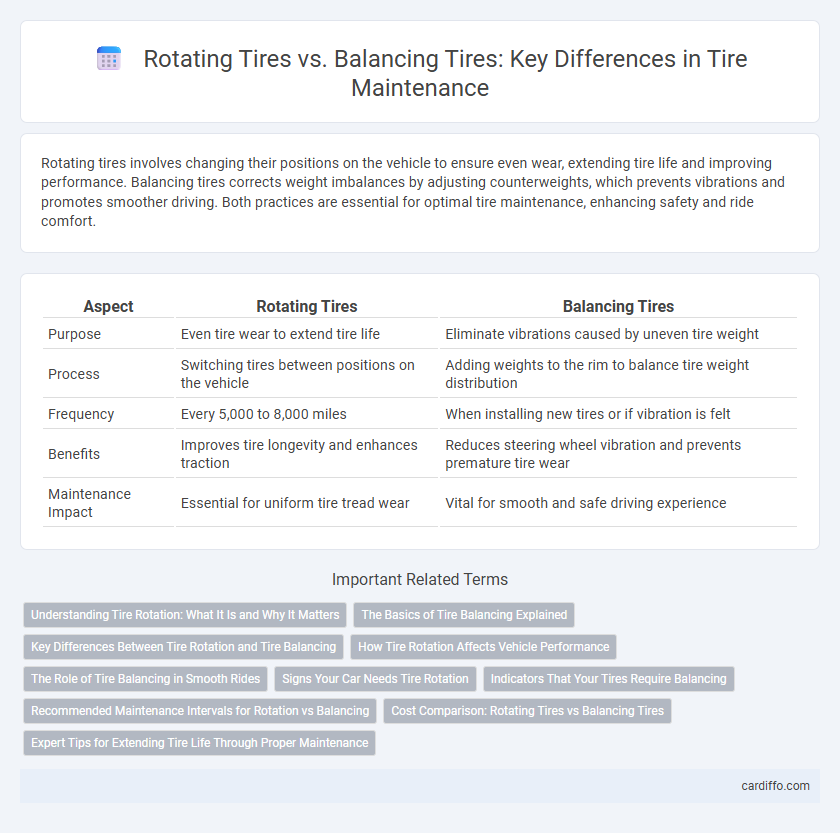Rotating tires involves changing their positions on the vehicle to ensure even wear, extending tire life and improving performance. Balancing tires corrects weight imbalances by adjusting counterweights, which prevents vibrations and promotes smoother driving. Both practices are essential for optimal tire maintenance, enhancing safety and ride comfort.
Table of Comparison
| Aspect | Rotating Tires | Balancing Tires |
|---|---|---|
| Purpose | Even tire wear to extend tire life | Eliminate vibrations caused by uneven tire weight |
| Process | Switching tires between positions on the vehicle | Adding weights to the rim to balance tire weight distribution |
| Frequency | Every 5,000 to 8,000 miles | When installing new tires or if vibration is felt |
| Benefits | Improves tire longevity and enhances traction | Reduces steering wheel vibration and prevents premature tire wear |
| Maintenance Impact | Essential for uniform tire tread wear | Vital for smooth and safe driving experience |
Understanding Tire Rotation: What It Is and Why It Matters
Tire rotation involves systematically changing the position of each tire on a vehicle to promote even tread wear and extend tire lifespan. Unlike tire balancing, which addresses uneven weight distribution to prevent vibrations, rotation focuses on equalizing tread wear patterns caused by different driving dynamics on each wheel. Regular tire rotation enhances vehicle stability, improves fuel efficiency, and ensures safer handling by maintaining consistent tire performance.
The Basics of Tire Balancing Explained
Tire balancing involves adjusting the weight distribution of a tire and wheel assembly to ensure smooth rotation and prevent vibrations while driving. Unlike rotating tires, which changes the position of tires to promote even wear, balancing corrects imbalances caused by weight irregularities in the tire or wheel. Proper tire balancing improves vehicle handling, extends tire life, and enhances overall driving comfort.
Key Differences Between Tire Rotation and Tire Balancing
Tire rotation involves changing the position of each tire on the vehicle to ensure even tread wear and extend tire life, typically recommended every 5,000 to 7,500 miles. Tire balancing corrects uneven weight distribution on each wheel and tire assembly by adding small weights, preventing vibrations and ensuring smooth driving. Both procedures are essential for vehicle safety and performance but address different maintenance needs: wear distribution versus wheel stability.
How Tire Rotation Affects Vehicle Performance
Tire rotation promotes even tread wear by systematically changing tire positions, enhancing traction and extending tire lifespan. Uneven tire wear without rotation can lead to decreased vehicle stability, reduced fuel efficiency, and compromised braking performance. Regular rotation maintains balanced handling and prevents premature tire replacement, ensuring consistent driving safety and optimal vehicle performance.
The Role of Tire Balancing in Smooth Rides
Tire balancing is essential for maintaining a smooth ride by evenly distributing weight around the wheel and tire assembly, preventing vibrations and uneven tire wear. Unlike rotating tires, which simply change tire positions to promote even tread wear, balancing corrects imbalances caused by manufacturing imperfections or wear. Properly balanced tires enhance vehicle stability, improve fuel efficiency, and extend the lifespan of suspension components.
Signs Your Car Needs Tire Rotation
Uneven tread wear, vibrations while driving, and reduced traction often indicate the need for tire rotation. Tires wear differently based on their position, with front tires typically showing signs of faster wear due to steering and braking forces. Regular tire rotation every 5,000 to 8,000 miles helps maintain even tread wear, prolonging tire life and improving vehicle handling.
Indicators That Your Tires Require Balancing
Uneven tire wear, such as bald spots or tread wearing faster on one side, is a clear indicator that your tires require balancing. Vibrations felt in the steering wheel or through the floorboard while driving at higher speeds suggest imbalanced tires impacting vehicle stability. Misalignment with repeated tire rotation but persistent vibration signals the need for professional tire balancing to ensure smooth operation and extended tire life.
Recommended Maintenance Intervals for Rotation vs Balancing
Tire rotation is generally recommended every 5,000 to 7,500 miles to ensure even tread wear and extend tire life, while tire balancing should be checked every 6,000 to 8,000 miles or when experiencing vibrations. Regular rotation aligns tires to different positions on the vehicle, reducing uneven wear patterns, whereas balancing corrects weight distribution around the wheel for smooth driving. Following these maintenance intervals helps optimize tire performance, safety, and fuel efficiency throughout the tire's lifespan.
Cost Comparison: Rotating Tires vs Balancing Tires
Rotating tires typically costs between $20 and $50 per service, addressing uneven tire wear and extending tire lifespan, while balancing tires usually ranges from $40 to $70, focusing on eliminating vibrations and improving ride comfort. Regular tire rotation is more cost-effective over time as it prevents premature tire replacement, whereas balancing is a necessary expense after tire installation or repair to maintain vehicle stability. Combining both services during maintenance optimizes tire performance and safety, potentially reducing overall long-term vehicle maintenance costs.
Expert Tips for Extending Tire Life Through Proper Maintenance
Rotating tires regularly, ideally every 5,000 to 7,500 miles, ensures even tread wear and prolongs tire lifespan by distributing friction across all tires. Balancing tires prevents uneven wear by correcting weight imbalances, reducing vibrations and strain on suspension components. Combining both practices with regular alignment checks optimizes tire performance and maximizes durability.
Rotating Tires vs Balancing Tires Infographic

 cardiffo.com
cardiffo.com